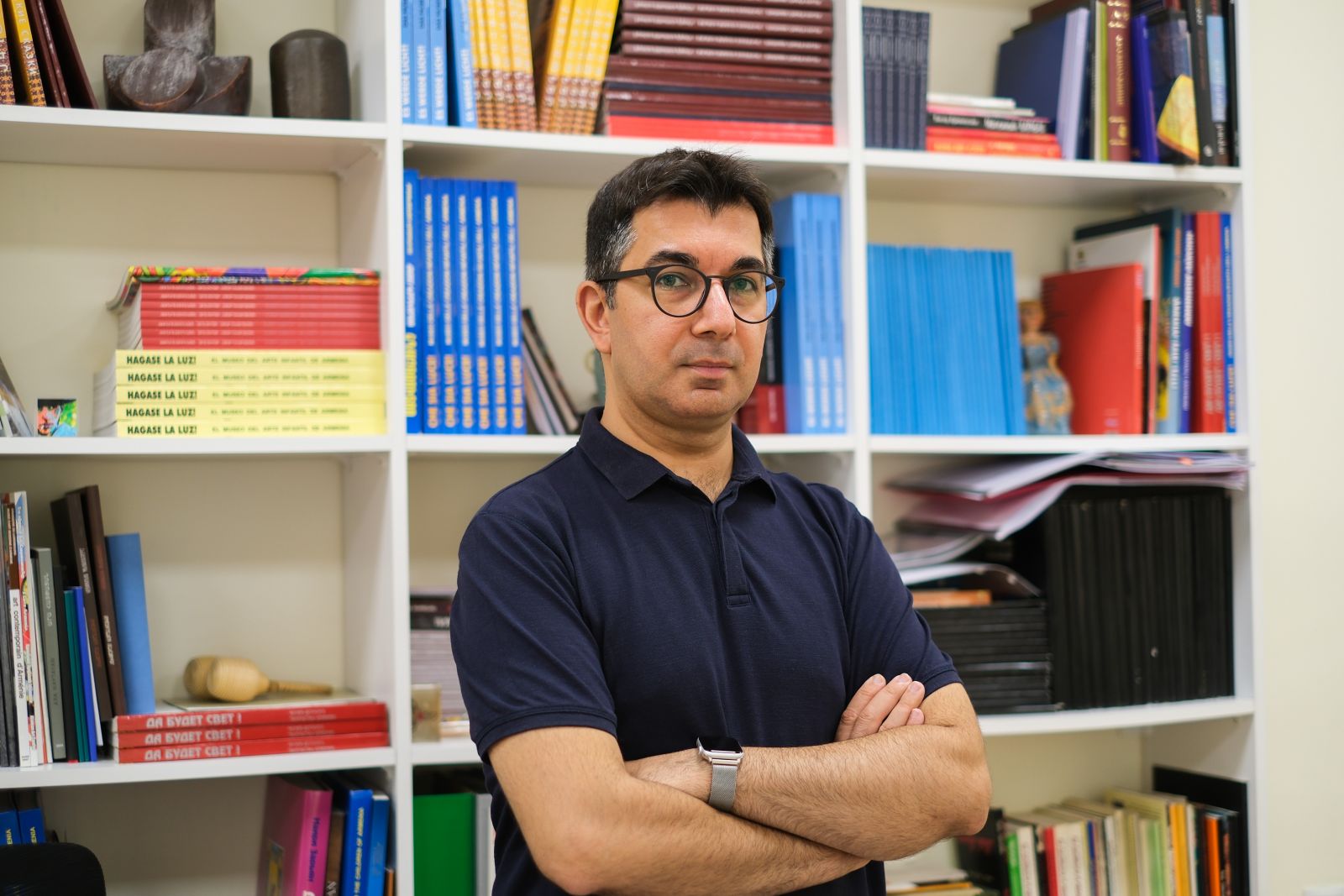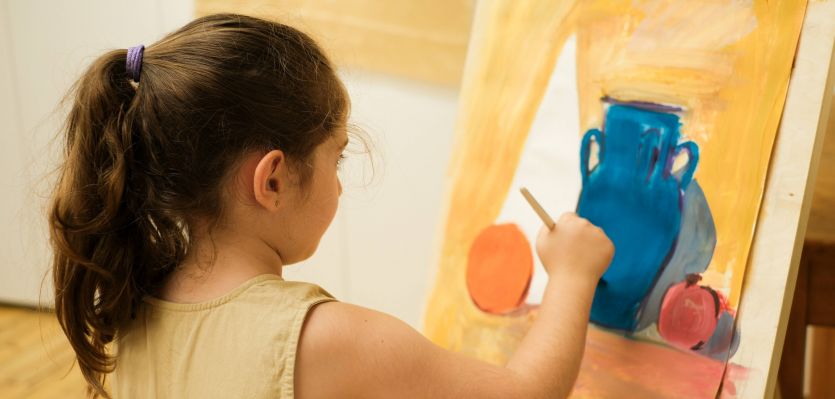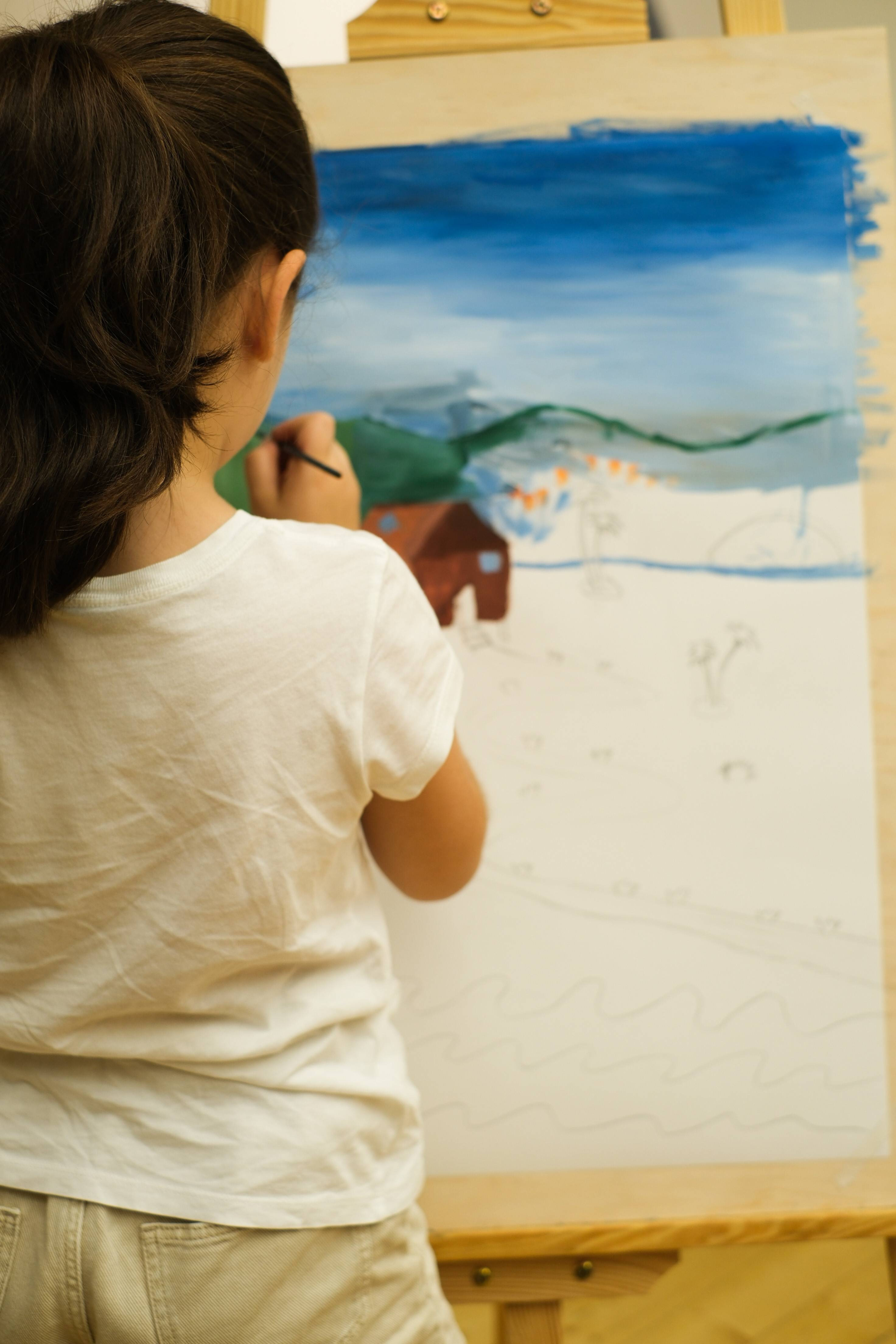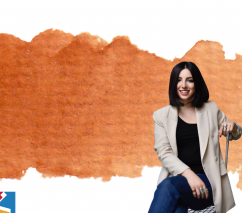Interview | NCA: A Tour Through Children’s Art & Aspirations
September 23, 2024
A row of sculptures of mystical characters and creatures greet you as you walk along Abovyan Street in Yerevan. They are protectors of the first children’s art museum in the world. The Henrik Igityan National Centre for Aesthetics is an educational institution that provides cross-disciplinary inclusive art education and promotes the wonderful art created by children from all around Armenia. In this exclusive interview with h-pem, the General Director Vahan Badalyan, and NCA Inclusive Training Centre Coordinator Sona Budaghyan talk about the curation of the exhibitions and the impact and importance of their mission.
Walking into a space that is purely catered to showcasing artwork created by children is genuinely magical. Though most of us have had our fair share of visiting museums, I’d never considered that every artwork I have encountered in a public space – not including parent-student-teacher conferences and children’s art classes – is created by adults. Art, regardless of the medium, is a portal into another world giving us a ticket to experience a perspective that is unfamiliar to our own. And when one compares a child’s mind to an adult’s we start realizing that we have long forgotten to nurture our inner child, left in neglect like an overgrown garden that needs its weeds tended.
As I studied the walls of art, it awakened a sensation of lost memory in me. Not just flashbacks from beloved art classes, the feeling of nervousness when you ask the teacher if you put too much red paint on the canvas, or watching the colors mingle in the drain when you wash your hands after class is over. But it was also admiring what the children chose to capture. An ink-etched Cheburashka I instantly recognize. In the same collection, a familiar scene from the enchanting city of Venice, Italy. There is also a cabin in the woods which I initially perceive as a classic scene, but upon observing it closer, I notice the starry night sky and chimney smoke mingle to form a silhouette any Armenian would recognize the “We Are Our Mountains” statue from Artsakh. The piece is called “My Home”.
After walking through the gallery, I was greeted by Sona Budaghyan and Vahan Badalyan, who gave me a tour of the workshop space, a brightly lit room adorned with canvases that had glimpses of the current still life the kids were painting. There are three different still-life sets up waiting to be given a second life. One was composed of a gauzy orange fabric, a cone-shaped hat, and a dried pomegranate, the second was a glossy jug next to a lemon and a matte jug, and lastly, there was an antique oil lamp with a variety of fruit by its side. They are excited that I will be here to see the classes spring to life. Before it begins, I am eager to learn more about the gallery and how they were curated.
(1).png)
Lilit Davtyan: Why do you think it's important to involve children in the arts?
Vahan Badalyan: We believe that art plays a crucial role in the holistic development of every child. It provides diverse languages of self-expression and nurtures values that can contribute to the creation of more peaceful societies in the future.
LD: What impact do you want NCA to have on kids? What do you hope they take out from the workshops or having their art featured in galleries?
VB: The National Centre for Aesthetics (NCA) was initially founded to develop aesthetic taste and art appreciation among Armenian children. Furthermore, it was founded to build on the legacy of the world’s first Children’s Art Museum established in 1970 in Yerevan. Although we have since broadened our scope to include a wider age range, our core mission remains the same. We continue to focus on promoting children's art both locally and globally.
LD: How does NCA come up with exhibition themes and artist selection? Tell us a little about the curation of the entire exhibition.
VB: The exhibition themes are typically determined at the beginning of the academic year through close collaboration with NCA teachers, who then design their curriculum around these themes. For instance, the theme for the 2023-2024 academic year is dedicated to the 100th anniversaries of Sergei Parajanov and Charles Aznavour. These projects always culminate in exhibitions of children’s artworks at the NCA Gallery and Museum, with the curation being a joint effort between NCA teachers and curators.
LD: What was your favorite or most successful exhibition? Why did it stand out to you?
VB: The exhibitions organized as part of NCA’s annual Pan-Armenian Art Competitions hold a special significance. For decades, these exhibitions have brought together thousands of Armenian children, not only from Yerevan and across Armenia’s regions but also from Artsakh and the Diaspora. These theme-based projects which conclude with exhibitions have been integral to NCA's curriculum since the 1980s, and are now enriched by study visits, online lectures, and video tutorials. Depending on the project theme, these initiatives are often organized in close collaboration with relevant national cultural institutions.
Slowly but surely the pitter-patter of children’s footsteps starts trickling in for the art workshop. It is delightful to see the difference in age ranges and the medium of art the children want to use. A girl runs down the stairs with her beloved packet of markers in hand, she is working on a drawing with an array of hearts and flowers. There is also a boy who is still in the sketching phase of his piece, but he quickly gets to painting in the yellows of the lemon from the still life. Watching them dip their paint brushes in spill-proof containers as they shyly raise their hand when they need a different color of paint warmed my heart. They all look so focused and captured by the art they are creating, it made me want to pull up a tiny stool and sit in front of my own canvas. It was such a comforting setting, completely catered to inspire them to create something they would look back on with pride. Teachers walk around patiently asking them if they need help conveying a mountainous scenery, little chatters about their summer breaks and how it’s been going so far, and questions regarding certain students that are absent and theories of why they are not there today. It was all blurring into a nostalgic trance that I did not want to leave, eventually needing to snap back into the mundanity of the adult world. I was curious to hear more about how the workshops had come to be and what made them special to the NCA.
.png)
LD: What plans do you have for the workshops? How long has the project been in the making and how has it been so far?
VB: Over the past two months, we have been designing art workshops for children to pilot them and prepare them for the ARTAKARG Universal Studio. ARTAKARG Universal Studio is an interactive and inclusive art studio within the NCA Museum, where visitors can enrich their experience through hands-on, experiential art education. The results have been quite promising, as we successfully engaged over 100 children during the pilot stage. We are optimistic that once the renovation at the NCA Museum is complete, it will become more visible and attractive to art enthusiasts.
LD: Since your involvement with Artbox, how has your center progressed? What aspects of your center have you seen the most improvement in?
VB: Our involvement with Artbox allowed us to launch a comprehensive development strategy to revitalize the NCA Museum and Gallery. Additionally, the upgrade will incorporate advanced museum technologies supported by the Artbox HUB program, improving the overall functionality and experience of our cultural spaces. We also successfully applied for and received financial support from the H. Hovnanian Family Foundation to renovate the Museum area. This renovation also includes the installation of an elevator, which will connect the NCA Museum to the Gallery, ensuring accessibility for people with disabilities.
The art workshops are not the only classes that the NCA is working on expanding and hosting. They also have a theater performance space and group called the Small Theatre in the works for the upcoming fall season. It is always a treat to witness eyes sparkle as people explain the levels of effort and passion that go into crafting these projects into reality. It is evident that the children that attend the workshops are in pure bliss and it is a highlight of their week. Considering the joy they put into creating the work, it is pleasing to imagine the spark they feel seeing their very own creations displayed on the walls.
.png)
VB: The NCA Small Theatre has consistently been recognized as one of the most innovative theatrical companies in Armenia. We are committed to delivering high-quality theatrical education and artistic productions that continuously push creative boundaries. This year, we have furthered our commitment to inclusive performing arts practices by collaborating with the Swedish ShareMusic & Performing Arts. In September and October, we will collaborate with the Italian Orbita Spellbound Centre on the "Fatigue" Performing Arts Project, bringing together Armenian artists with an Italian choreographer and music producer for a contemporary dance production to be presented in the frames of HIGH FEST International Performing Arts Festival in Yerevan. Our entire team will be actively involved in the 100th Anniversary Celebration of Sergei Parajanov scheduled for October. Our plans for the rest of the year also include staging three new performances, one specifically for children.
LD: What classes do you hope to add in the future?
VB: ARTAKARG Universal Studio will provide workshops and master classes catering to a wide audience, including preschool-age and teenage children, adults, families, corporate teams, individuals with disabilities, tourists, and anyone interested. These sessions will encompass a diverse array of fine arts and decorative applied arts.

LD: What plans does NCA have for the future? How do you plan to expand your outreach?
VB: We aim to become a modern cultural institution equipped with state-of-the-art facilities, committed to delivering high-quality artistic education and production that is accessible to all. The organization will ensure that all its subdivisions are accessible and inclusive, welcoming individuals from diverse backgrounds and abilities. NCA is actively revitalizing its premises and establishing new subdivisions and art centers, aiming for broad geographic outreach and decentralized art education. Currently, NCA operates across 13 subdivisions in Yerevan and extends its services to five regions of Armenia: Shirak, Lori, Tavush, Gegharkunik, and Syunik.
As our discussion and day came to a close, they had one more place to show me. It is a room with a big wall that extends up to the very top, purely composed of empty white shelves. Vahan Badalyan explains how their plans include filling the entirety of the shelves with books to serve as sources for children to come to enjoy and be inspired by. In a world that is constantly preoccupied with promoting the bettering of ourselves and our own aspirations, it is moving to have spent an entire afternoon in a space that is completely catered to inspiring and celebrating children. Whether it is getting them in front of a canvas to paint, sitting on a little stool to read a book that could change the trajectory of their imagination, or the exhilaration of seeing their work on the walls. Appreciating children’s art and giving them their own space to create is like stumbling upon a divine middle ground, just enough rain and sunshine to create an unexpected rainbow in the hustle and bustle of a city.
About the NCA
The Henrik Igityan National Centre for Aesthetics is one of the largest educational and cultural institutions, operating under the auspices of the RA Ministry of Education, Science, Culture, and Sports. With its origins traced back to the world's inaugural Children’s Art Museum founded in 1970, NCA boasts a rich 54-year legacy of cultural and educational excellence. NCA offers wide geographic outreach and decentralized art education, spanning across 13 subdivisions in Yerevan and five regions of Armenia: Shirak, Lori, Tavush, Gegharkunik, and Syunik. In Yerevan, NCA is the home to the NCA Gallery and Museum, NCA Small Theatre, NCA Studios, NCA Dance School, "Metro" theater-studio, and NCA Inclusive Training Centre for Performing Arts, NCA Music School of National Instruments.
Join our community and receive regular updates!
Join now!





















Attention!